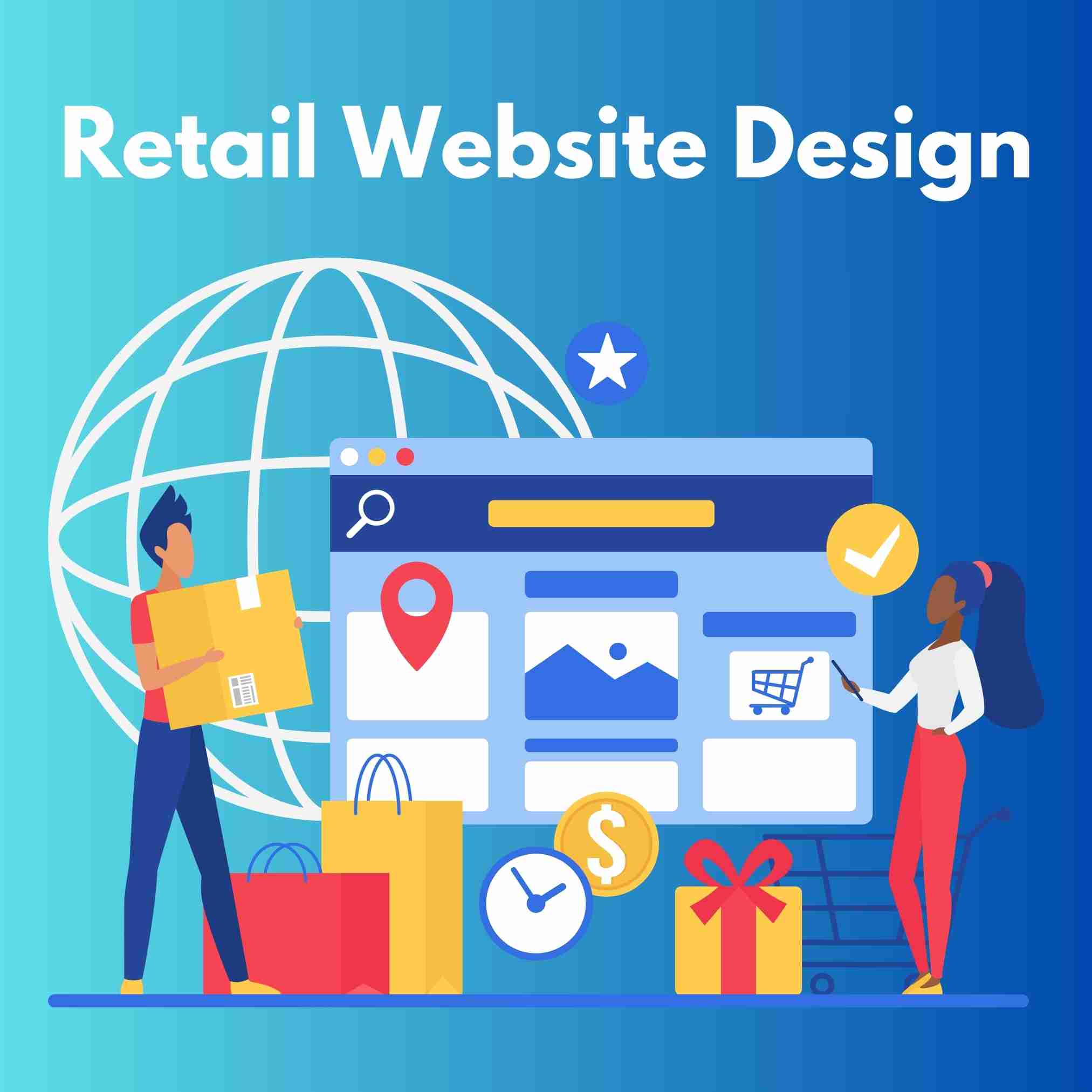Retail Website Design: A Comprehensive Guide

Retail Website Design – In the fast-paced world of e-commerce, the design of your retail website plays a pivotal role in attracting and retaining customers. A well-designed website not only enhances user experience but also builds trust, establishes brand identity, and ultimately drives sales. In this comprehensive guide, we will delve into the intricate details of retail website design, covering everything from the importance of a user-centric approach to the latest design trends and optimization techniques. Let’s embark on a journey to unravel the art and science behind creating a successful online retail presence.
The Art and Science of Retail Website Design: A Comprehensive Guide
A. Understanding the Significance of Retail Website Design
1. User-Centric Approach: The Foundation of Success
- A user-centric design is at the core of every successful retail website. Understanding your target audience, their needs, and behaviors is paramount. Conducting thorough user research helps in creating a website that not only appeals visually but also addresses the users’ pain points.
2. Responsive Design: Catering to Every Device
- In an era where users access websites from various devices, ensuring a seamless experience across desktops, tablets, and smartphones is non-negotiable. Responsive design adapts your website’s layout and content dynamically, providing an optimal viewing experience regardless of the device.
3. Intuitive Navigation: Guiding the Customer Journey
- Navigating through a retail website should be an effortless experience. Implementing clear and intuitive navigation ensures that visitors can easily find what they are looking for. Well-organized menus, search functionality, and strategically placed CTAs (Call-to-Action) contribute to a smooth customer journey.
4. Loading Speed: The Need for Speed
- Patience is a rare virtue in the digital age. Slow-loading websites can lead to high bounce rates and frustrated customers. Optimize images, leverage browser caching, and invest in a reliable hosting infrastructure to ensure your website loads swiftly.
B. Elements of Effective Retail Website Design
1. Striking Visuals: Capturing Attention
- Humans are visual beings, and the aesthetics of your website can significantly impact user perception. High-quality images, engaging product photography, and a visually appealing layout contribute to a positive first impression.
2. Consistent Branding: Building Trust
- Your website is an extension of your brand. Maintaining consistency in colors, fonts, and overall design elements instills trust and reinforces brand identity. A cohesive visual identity across all touchpoints fosters a sense of professionalism.
3. Compelling Product Pages: Showcasing the Goods
- The product pages are the heart of any retail website. Provide comprehensive product information, including detailed descriptions, specifications, and high-resolution images. Implement user-friendly navigation within product categories, enabling customers to explore effortlessly.
4. Effective Call-to-Action (CTA): Encouraging Conversions
- A well-crafted CTA guides visitors toward desired actions. Whether it’s making a purchase, signing up for newsletters, or navigating to specific sections, strategically placed and enticing CTAs enhance user engagement and drive conversions.
5. User-generated Content: Harnessing Social Proof
- Encourage customers to leave reviews, share their experiences, and contribute user-generated content. Authentic testimonials and positive reviews build trust and serve as valuable social proof, influencing potential customers’ purchasing decisions.
6. Personalization: Tailoring the Experience
- Leveraging customer data to personalize the browsing experience can significantly impact user satisfaction. Implementing features such as personalized recommendations based on previous purchases or user preferences enhances engagement and increases the likelihood of conversions.
C. Staying Ahead with Modern Design Trends
1. Minimalism: Less is More
- The minimalist design philosophy continues to dominate the digital landscape. Simplified layouts, ample white space, and focused content convey a sense of elegance and make navigation more straightforward.
2. Microinteractions: Enhancing User Engagement
- Microinteractions, subtle animations or visual responses to user actions, contribute to a more dynamic and engaging website. From button hovers to scrolling effects, these small details can significantly enhance the overall user experience.
3. Dark Mode: A Stylish Choice
- Dark mode has transitioned from a trend to a staple feature. Not only does it offer a stylish aesthetic, but it also reduces eye strain in low-light conditions. Providing users with the option to switch between light and dark modes adds a layer of customization.
4. Voice Commerce: The Rise of Voice Search
- With the increasing prevalence of voice-activated devices, optimizing your retail website for voice search is becoming crucial. Consider incorporating voice search functionality and ensuring that your product descriptions are structured to align with common voice queries.
5. Augmented Reality (AR): Virtual Try-ons
- AR technology is revolutionizing the online shopping experience. Integrating virtual try-on features for apparel or AR visualization for furniture allows customers to visualize products in their real-world context, enhancing confidence in purchasing decisions.
6. Chatbots and AI: Enhancing Customer Support
- AI-driven chatbots offer instant assistance, helping customers navigate the website, find products, and address queries. Implementing machine learning algorithms can personalize recommendations based on user behavior, creating a more interactive and tailored shopping experience.
D. The Technical Backbone: SEO and Performance Optimization
1. SEO Best Practices: Climbing the Search Rankings
- A visually stunning website is only effective if potential customers can find it. Implementing SEO best practices, including keyword optimization, meta tags, and creating a sitemap, ensures that search engines recognize and rank your pages appropriately.
2. Mobile Optimization: A Non-Negotiable Requirement
- Mobile optimization extends beyond responsive design. Ensure that your website is mobile-friendly by optimizing images, using mobile-friendly navigation menus, and prioritizing mobile page speed. Google’s mobile-first indexing emphasizes the importance of catering to mobile users.
3. Security Measures: Building Trust
- With the increasing prevalence of cyber threats, prioritizing website security is paramount. Implement SSL certificates, secure payment gateways, and regularly update your website’s software to safeguard customer data and build trust in your online platform.
4. Performance Monitoring: Fine-tuning for Excellence
- Regularly monitor your website’s performance using tools like Google PageSpeed Insights. Identify and address issues affecting loading times, optimize code, and ensure that your website remains in peak condition for a seamless user experience.
E. The Future of Retail Website Design
1. Blockchain Technology: Securing Transactions
- Blockchain is not just for cryptocurrencies; it’s making waves in e-commerce too. Implementing blockchain technology enhances the security of online transactions, providing customers with a transparent and secure shopping environment.
2. Sustainability: A Design Ethos
- The rising awareness of environmental concerns has led to a demand for sustainable practices in every industry, including e-commerce. Consider incorporating eco-friendly design elements, emphasizing sustainable products, and transparently communicating your commitment to environmental responsibility.
3. Emotional Design: Creating Connections
- Going beyond aesthetics, emotional design aims to connect with users on a deeper level. By incorporating design elements that evoke positive emotions, you can create a memorable and impactful online shopping experience.
4. AI-driven Personalization: Hyper-personalized Experiences
- The future of retail website design involves even more advanced personalization powered by artificial intelligence. AI algorithms will analyze user behavior in real-time, delivering hyper-personalized recommendations and experiences tailored to individual preferences.
5. Immersive Technologies: Virtual and Augmented Reality
- As technology advances, the integration of virtual and augmented reality will become more seamless. Retail websites will offer immersive experiences, allowing customers to virtually explore products, try them on, and visualize how they fit into their lives.
Conclusion: Retail Website Design
In the ever-evolving landscape of e-commerce, retail website design remains a critical aspect of success. By combining a user-centric approach with striking visuals, embracing modern design trends, and optimizing for performance and SEO, you can create a website that not only attracts visitors but also converts them into satisfied customers.
As we look toward the future, staying abreast of emerging technologies and design philosophies will be key to maintaining a competitive edge. Whether it’s integrating blockchain for secure transactions, prioritizing sustainability, or harnessing the power of AI for hyper-personalization, the possibilities are vast.
Remember, a retail website is not just a virtual storefront; it’s a dynamic space where technology, design, and user experience converge to create a digital shopping journey. As you embark on the journey of designing or refining your retail website, let this guide serve as a compass, guiding you through the intricacies of creating an online presence that captivates, engages, and ultimately succeeds in the ever-expanding realm of e-commerce.
Recommended Posts

Local SEO vs. Global SEO: A Comprehensive Guide
May 14, 2025



